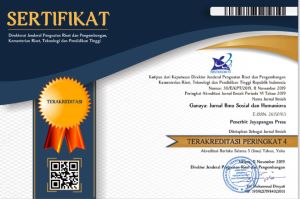Transformasi Tradisi Perang Obor Jepara Dalam Perancangan Coffee Table dengan Metode ATUMICS
DOI:
https://doi.org/10.37329/ganaya.v8i3.4181Keywords:
Design, Coffee Table, Culture, Perang Obor, JeparaAbstract
The Perang Obor tradition in Jepara is one of the local cultural heritages that contains spiritual, symbolic and community identity values. This research aims to explore and transform the visual and philosophical elements of the tradition into contemporary furniture design in the form of a coffee table. The approach used is culture-based design with the application of the ATUMICS (artifact, technique, utility, material, icon, concept, shape) analysis method as a systematic framework in the design process. Data was obtained through visual observation of the implementation of traditions, documentation of cultural elements, and literature studies on symbolic values and product design aspects. The analysis process was conducted to determine the elements of tradition that can be maintained, modified, or eliminated in the realization of modern design. The results show that the main symbol in the form of a torch can be interpreted visually through the shape of table legs, decorative patterns, and a combination of materials such as wood and rattan that represent the flame and simplicity of local values. The final design not only fulfills functional and aesthetic aspects, but also conveys a strong cultural narrative, making the furniture a medium of preservation and expression of Jepara's cultural identity. This innovation proves that the ATUMICS method is effective in integrating traditional heritage into modern, contextually relevant design products. The design results also have the potential to expand the scope of culture-based design in the local creative industry that is oriented towards the preservation of traditional values.
References
Ardini, S. P., & Winata, G. (2023). Analisis Bentuk Produk Keramik Studio Mandiri Dengan Tema Tradisi Lokal Indonesia Melalui Pendekatan ‘Atumics’. Panggung, 33(4), 565-577.
Aristanto, Z. (2011). Perang Obor Upacara Tradisi di Tegal Sambi, Tahunan, Jepara. Sabda: Jurnal Kajian Kebudayaan, 6(1), 88-94.
Bawon, P., Ismail, M. H., Kassim, N. S. A., & Rahmawaty, R. (2024). The Preference for Purchasing Rattan Furniture among Residents in Taman Bukit Chandan, Kuala Kangsar, Perak, Malaysia. Semarak International Journal of Agriculture, Forestry and Fisheries, 1(1), 1-9.
Buchanan, A. H., & Levine, S. B. (1999). Wood-Based Building Materials And Atmospheric Carbon Emissions. Environmental Science & Policy, 2(6), 427-437.
Edward, B. R. W., Savitri, M. A., & Gabriella, I. (2022). Pengaplikasian Modul ‘ATUMICS’ Pada Bidang Desain Industri Furnitur Rotan. Productum: Jurnal Desain Produk (Pengetahuan Dan Perancangan Produk), 5(1), 25-36.
Freitas, J. A., Sanquetta, C. R., Iwakiri, S., & Costa, M. R. M. M (2021). The Use Of Wood Construction Materials As A Way Of Carbon Storage In Residential Buildings In Brazil. International Journal of Construction Management, 21(3), 292-298.
Gumulya, D. (2022). Eksplorasi Material Inspirasi Gaya Art Nouveau Bertemu Dengan Ikon Indonesia Dengan Metode ATUMICS. Jurnal Da Moda, 3(2), 69-78.
Guo, Z., Tian, Z., Liu, Y., Ding, L., Jiang, S., Wu, W., Duan, G. (2025). A Review Of Cellulose And Lignin Contained Rattan Materials: Structure, Properties, Modifications, Applications And Perspectives. International Journal of Biological Macromolecules, 290, 139081.
Hasanain, B. (2024). The Role of Ergonomic and Human Factors in Sustainable Manufacturing: A Review. Machines, 12(3), 2-27.
Huang, W., Rahman, A. R. A., Gill, S. S., & Effendi, R. A. A. R. A. (2025). Furniture Design Based On Cultural Orientation: A Thematic Review. Cogent Arts & Humanities, 12(1).
Kartika, D. S. (2004). Pengantar Estetika. Bandung: Rekayasa Sains.
Koentjaraningrat, K. (1985). Mentalitas Dan Pembangunan. Jakarta: Gramedia Pustaka Utama
Kusumaningrum, N., Hutasoit, N., Prakoso, G., & Sundara, G. (2024). Desain Extendable Coffee Table Dengan Fitur Internet Of Things (IoT). Productum: Jurnal Desain Produk (Pengetahuan Dan Perancangan Produk), 7(2), 111-120.
Langer, S. K. (1953). Feeling and Form A Theory of Art. New York: Charles Scribner’s.
Maurya, C., & Maurya, N. (2022). Ancient Indian Ergonomics Wisdom And Its Contemporary Significance. Theoretical Issues in Ergonomics Science, 23(2), 245-258.
Prameswari, I., Hibino, H., & Koyama, S. (2017). The Role Of Cultural Schema In Developing Culture-Based Product Design. Journal of the Science of Design, 1(1), 57-66.
Punhagui, K. R. G., & John, V. M. (2022). Carbon Dioxide Emissions, Embodied Energy, Material Use Efficiency Of Lumber Manufactured From Planted Forest In Brazil. Journal of Building Engineering, 52, 104349.
Sabaniyah, A., & Yuanditasari, A. (2024). Studi Transformasi Bentuk pada Desain Furniture Berbasis Budaya Lokal Suku Dayak Sebagai Wujud Pelestarian Kebudayaan. Lintas Ruang: Jurnal Pengetahuan Dan Perancangan Desain Interior, 12(1), 40-51.
Sudarmaji, & Mirasanti, N. (2023). Buku Panduan Guru Dasar-Dasar Teknik Furnitur. Buku Sekolah Elektronik (BSE).
Wismoyo, E. A., Hadiansyah, M. N., Putri, A., Awaloka, F., Yashila, L., & Nurul, R. (2024). Atumics Methods Implementation: Work and Eat Activity Improvement in Warunk Upnormal as Study Case. Journal of Architectural Research and Design Studies, 8(1), 1-8.
Downloads
Published
How to Cite
Issue
Section
License
Copyright (c) 2025 Habib Hasan Abdi Masabdi, Indarto Indarto, Neni Nurul Rosalina (Author)

This work is licensed under a Creative Commons Attribution-ShareAlike 4.0 International License.
An author who publishes in the Ganaya : Jurnal Ilmu Sosial dan Humaniora agrees to the following terms:
- Author retains the copyright and grants the journal the right of first publication of the work simultaneously licensed under the Creative Commons Attribution-ShareAlike 4.0 License that allows others to share the work with an acknowledgement of the work's authorship and initial publication in this journal
- Author is able to enter into separate, additional contractual arrangements for the non-exclusive distribution of the journal's published version of the work (e.g., post it to an institutional repository or publish it in a book) with the acknowledgement of its initial publication in this journal.
- Author is permitted and encouraged to post his/her work online (e.g., in institutional repositories or on their website) prior to and during the submission process, as it can lead to productive exchanges, as well as earlier and greater citation of the published work (See The Effect of Open Access).
Read more about the Creative Commons Attribution-ShareAlike 4.0 Licence here: https://creativecommons.org/licenses/by-sa/4.0/.








